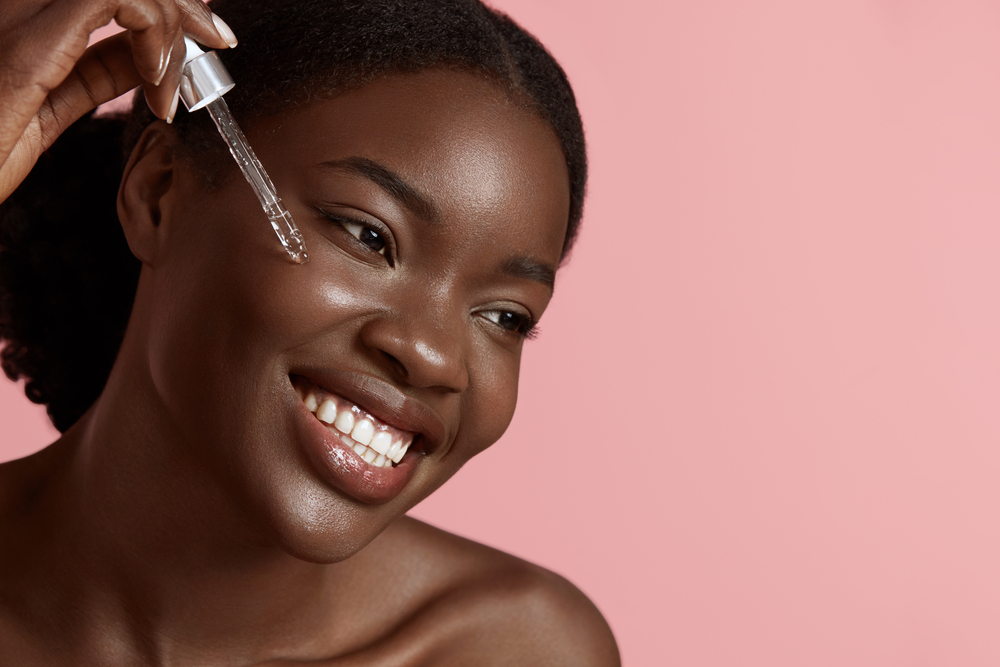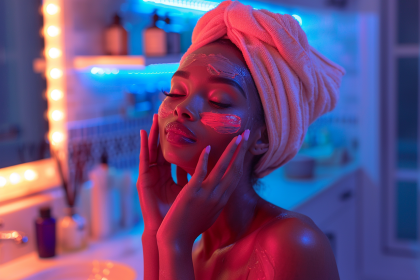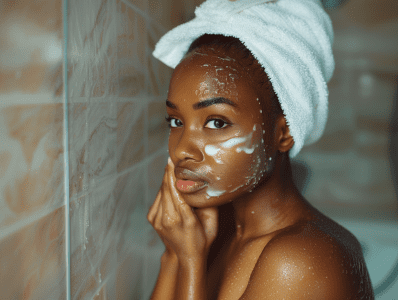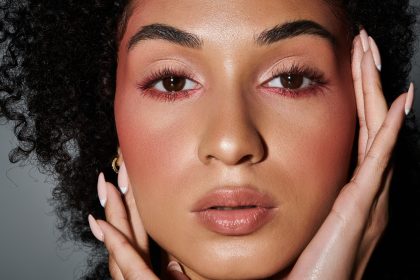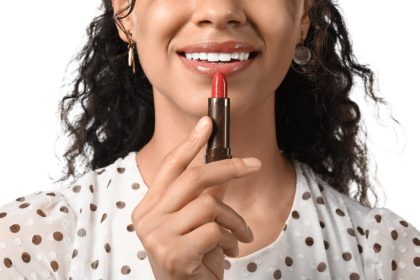Despite common misconceptions, melanin-rich skin requires dedicated sun protection just like any other skin tone. While natural melanin does provide some defense against the sun’s harmful rays, this built-in protection only goes so far – equivalent to approximately SPF 13, far below dermatologists’ recommended daily minimum. Understanding how to properly protect darker skin from sun damage helps prevent hyperpigmentation, premature aging, and reduces skin cancer risk while maintaining a radiant, even complexion.
Debunking the myth of natural sun immunity
The belief that darker skin doesn’t need sunscreen persists despite substantial evidence to the contrary. This misconception stems from the fact that melanin-rich skin indeed shows delayed signs of sun damage compared to lighter skin tones. However, this delayed visibility can actually increase risk, as damage accumulates silently before becoming apparent.
Melanin provides some natural protection by absorbing and dispersing UV radiation before it damages skin cells. However, this protection proves insufficient against prolonged or intense sun exposure. UVA rays, which penetrate deeply into the skin, can still cause significant damage regardless of melanin levels. These rays contribute to premature aging, collagen breakdown, and hyperpigmentation – concerns that often affect darker skin tones more visibly than lighter ones.
The skin cancer misconception particularly endangers those with darker skin. While melanoma rates are lower in people with more melanin, diagnosis often occurs at later, more dangerous stages. This delayed detection happens partly because both patients and some medical professionals mistakenly believe darker skin faces minimal skin cancer risk, leading to missed early signs.
When sun damage does occur in melanin-rich skin, it often manifests differently than in lighter skin tones. Instead of sunburn’s immediate redness, darker skin may experience subtle changes like increased warmth, tight feeling, or slight darkening that’s easily overlooked. More noticeable effects like hyperpigmentation, melasma, and post-inflammatory darkening develop gradually, making the connection to sun exposure less obvious.
Understanding these realities helps those with melanin-rich skin make informed decisions about sun protection rather than relying on myths that ultimately compromise skin health.
How sun damage uniquely affects darker skin tones
Sun exposure affects all skin types, but melanin-rich skin experiences some distinctive reaction patterns that make proper protection particularly important.
Hyperpigmentation represents the most common sun-related concern for darker skin tones. When exposed to UV radiation, melanin production increases as a protective response. In melanin-rich skin, this process often occurs unevenly, leading to darker patches and spots that may persist for months or even years. These discolorations prove particularly frustrating because they typically require consistent sun protection to prevent worsening, even as they’re being treated with brightening ingredients or professional procedures.
Melasma, characterized by symmetrical brown or grayish patches typically on the forehead, cheeks, and upper lip, affects darker skin tones more frequently than lighter ones. This stubborn condition has multiple triggers, but sun exposure plays a primary role in both causing and exacerbating it. Without diligent sun protection, even the most aggressive melasma treatments yield disappointing results.
Collagen breakdown occurs in all skin types with sun exposure, but manifests differently in darker skin. Rather than fine lines and wrinkles (which often appear later in melanin-rich skin), the first signs typically include textural changes, volume loss, and a dull appearance. This different presentation sometimes leads people to underestimate sun damage’s impact until more significant changes have occurred.
Post-inflammatory hyperpigmentation (PIH) intensifies with sun exposure. This condition, where skin darkens following inflammation from acne, eczema, or injuries, worsens significantly without sun protection. Many people with darker skin tones notice that even minor blemishes leave persistent dark marks when exposed to sunlight during the healing process.
Understanding these unique effects helps explain why sun protection remains essential for melanin-rich skin, despite delayed or different manifestations of damage compared to lighter skin tones.
Finding sunscreen that works for darker skin tones
The historical challenge of finding suitable sunscreens for darker skin stems from product formulations that left visible white or purple-gray casts. This aesthetic issue, while seemingly superficial, created a significant barrier to regular sunscreen use. Fortunately, modern formulations increasingly address this concern.
Mineral versus chemical formulations present the first decision point when selecting sunscreen for melanin-rich skin. Mineral (physical) sunscreens containing zinc oxide or titanium dioxide work by sitting on the skin’s surface to reflect UV rays. Traditional versions often leave the notorious white cast, but newer micronized formulations minimize this effect. Chemical sunscreens absorb UV rays and convert them to heat. These typically blend more seamlessly into darker skin but may cause irritation for those with sensitive skin.
Hybrid formulations combining both mineral and chemical filters offer an excellent middle ground for many. These products provide broad-spectrum protection while minimizing both white cast and potential irritation. The balance of ingredients varies between products, allowing individuals to find their optimal formulation.
Tinted options provide another solution for avoiding white cast. Products with subtle tints that match or blend with various darker skin tones have proliferated in recent years. These formulations often contain iron oxides, which not only eliminate white cast but also provide additional protection against visible light, which research suggests contributes to hyperpigmentation in darker skin.
Texture and finish considerations matter significantly for compliance. While many sunscreens work effectively, people only consistently use products they find pleasant. Those with oily skin often prefer mattifying, lightweight formulas that don’t exacerbate shine. Drier skin types benefit from hydrating, dewy-finish sunscreens that incorporate moisturizing ingredients like hyaluronic acid or glycerin.
Testing application techniques can improve results with challenging formulations. Using a smaller initial amount and taking time to thoroughly massage the product helps minimize white cast with mineral sunscreens. Applying in sections rather than all at once also improves blending. For special occasions where photography will occur, testing sunscreen under flash photography helps avoid unexpected flashback effects.
Beyond SPF: Understanding comprehensive sun protection
While finding the right sunscreen product represents a crucial step, comprehensive protection requires understanding several additional factors that influence effectiveness.
Broad-spectrum protection covers both UVA and UVB radiation. UVB rays primarily cause sunburn and play a major role in developing skin cancer. UVA rays penetrate more deeply, contributing to premature aging and hyperpigmentation. For darker skin tones particularly concerned with hyperpigmentation, ensuring broad-spectrum coverage is essential, as UVA protection prevents the deepening of existing dark spots and formation of new ones.
SPF numbers indicate protection level, with SPF 30 blocking about 97% of UVB rays and SPF 50 blocking about 98%. The relatively small percentage difference between higher SPF values explains why most dermatologists recommend at least SPF 30 for daily use and SPF 50+ for extended outdoor activities. For melanin-rich skin, this recommendation holds true despite the additional natural protection melanin provides.
Reapplication timing often gets overlooked. Even the most effective sunscreen degrades with time, sweat, and water exposure. Reapplying every two hours during continuous sun exposure maintains protection levels. For daily urban use with minimal direct sun exposure, morning application under makeup followed by touchups on exposed areas may suffice for office days, though midday reapplication ideally would occur before lunch breaks or outdoor activities.
Water resistance claims on sunscreen packaging follow regulated definitions. “Water-resistant (40 minutes)” means the SPF level stays effective after 40 minutes of water immersion, while “Water-resistant (80 minutes)” indicates protection for up to 80 minutes in water. No sunscreen is fully waterproof, making reapplication after swimming or sweating essential regardless of water resistance claims.
Visible light protection represents an emerging concern particularly relevant for darker skin tones. Research indicates that visible light (especially blue light from sun and screens) may contribute to hyperpigmentation in melanin-rich skin. Iron oxide-containing tinted sunscreens and products specifically formulated with visible light protection offer additional defense against these wavelengths that regular sunscreens might not fully address.
Incorporating sunscreen into daily routines
Consistent sun protection requires seamlessly integrating sunscreen into existing skincare and makeup routines to ensure daily compliance without adding significant time or complexity.
Morning skincare sequencing places sunscreen as the final step before makeup. After cleansing, any treatment products like vitamin C serum (which actually enhances sun protection) should be applied first, followed by lightweight moisturizer if needed, and finally sunscreen. Allow each product to absorb for 30-60 seconds before applying the next to prevent pilling or uneven application.
For makeup wearers, finding compatible product combinations prevents frustrating pilling or breakdown throughout the day. Generally, water-based foundations work best over water-based sunscreens, while silicone-based foundations pair better with silicone-based sunscreens. Testing combinations and allowing sunscreen to fully set before applying foundation improves results. Many primers contain SPF, but these typically aren’t applied in sufficient quantity to provide adequate protection alone.
Reapplication over makeup presents a common challenge. Several approaches help maintain protection without disturbing carefully applied makeup: SPF-containing setting sprays offer convenient reapplication, though they should supplement rather than replace initial cream or lotion sunscreen. Powder sunscreens applied with a brush work well for touch-ups, particularly for controlling midday shine. Cushion compacts with SPF provide another touch-up option that adds light coverage while refreshing sun protection.
Body protection often gets neglected compared to facial care. For daily activities with minimal sun exposure, focusing on commonly exposed areas like hands, neck, and arms may be sufficient. For beach days or outdoor activities, full-body application becomes essential. Sprays make application easier for hard-to-reach areas, though careful coverage remains important as spots are easily missed with spray formulations.
Seasonal adjustments help maintain protection year-round. While summer obviously requires vigilant protection, winter protection remains important as UVA rays penetrate clouds and windows. Snow reflection can actually intensify UV exposure. Additionally, those using active ingredients like retinoids or chemical exfoliants, which increase photosensitivity, must maintain sun protection regardless of season to prevent hyperpigmentation.
Professional treatments and sunscreen: The critical connection
For those investing in professional skin treatments, proper sun protection becomes even more crucial, as many effective procedures temporarily increase sun sensitivity while addressing concerns like hyperpigmentation.
Chemical peels, which remove layers of damaged skin to reveal fresher skin beneath, significantly increase sun sensitivity for days or weeks following treatment. This newly exposed skin can develop severe hyperpigmentation if exposed to sun without protection, sometimes creating worse discoloration than the original concern. Most dermatologists refuse to perform peels on patients who cannot commit to strict sun avoidance and protection post-procedure.
Laser treatments, increasingly calibrated for safe use on darker skin tones, target concerns like hyperpigmentation, scarring, and textural issues. However, these treatments often create controlled damage to stimulate healing, leaving skin vulnerable during the recovery period. Sun exposure during this time can cause permanent discoloration that proves extremely difficult to correct.
Prescription retinoids, cornerstone treatments for both acne and anti-aging, thin the skin’s outer protective layer. This increases both the skin’s vulnerability to sun damage and the penetration of sunscreen, making careful, generous application particularly important. Without diligent sun protection, retinoid users often develop worse pigmentation despite the product’s benefits for skin cell turnover.
Hydroquinone and other brightening ingredients prescribed for hyperpigmentation become counterproductive without sunscreen. These products work by suppressing melanin production, but sun exposure stimulates more melanin, essentially canceling their effects. The resulting cycle of treatment without protection leads to frustration and unnecessary product expenditure without visible improvement.
The investment protection perspective helps motivate consistent sun protection. Professional treatments and medical-grade skincare products often represent significant financial investment. Using proper sun protection essentially protects this investment by ensuring treatments deliver their maximum benefit rather than being undermined by continued sun damage.
Sun-protective habits beyond sunscreen
While sunscreen provides essential protection, complementary strategies create comprehensive defense against sun damage for melanin-rich skin.
Protective clothing offers reliable physical protection that doesn’t need reapplication. Tightly woven fabrics in darker colors generally provide better UV protection than loose-weave, light-colored options. Many brands now create specifically designed sun-protective clothing with UPF (Ultraviolet Protection Factor) ratings, indicating the fraction of UV radiation that penetrates the fabric. UPF 50+ blocks 98% of UV rays and provides excellent protection for high-exposure activities.
Strategic timing helps avoid peak UV intensity. UV radiation typically reaches maximum strength between 10 AM and 4 PM. Planning outdoor activities outside these hours significantly reduces exposure. This doesn’t eliminate the need for sunscreen but provides an additional layer of protection, particularly important for those with hyperpigmentation concerns.
Accessories provide targeted protection for commonly damaged areas. Wide-brimmed hats shield the face, ears, and neck – areas particularly prone to sun damage and challenging to protect consistently with sunscreen alone. UV-blocking sunglasses protect both the eyes and the delicate skin around them where signs of aging often appear first. These accessories offer both fashionable and functional benefits for sun protection.
Environmental awareness helps anticipate protection needs. Reflective surfaces like water, snow, and even concrete can significantly amplify UV exposure beyond what might be expected based on weather conditions alone. Similarly, higher altitudes increase UV intensity, with approximately 4-5% stronger radiation for every 1,000 feet above sea level. These factors necessitate more frequent reapplication and higher SPF when enjoying mountainous or highly reflective environments.
Dietary support complements topical protection. Foods rich in antioxidants like tomatoes (lycopene), citrus fruits (vitamin C), and leafy greens (various antioxidants) help the body fight oxidative stress caused by UV exposure. While diet never replaces sunscreen, research suggests these nutrients may provide some additional cellular protection against damage.
By combining effective sunscreen with these complementary strategies, those with melanin-rich skin can maintain both the health and beauty of their skin for decades to come, preventing the hyperpigmentation and textural changes that often become significant concerns as darker skin ages.

